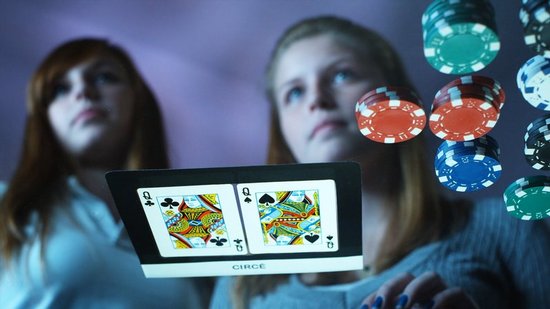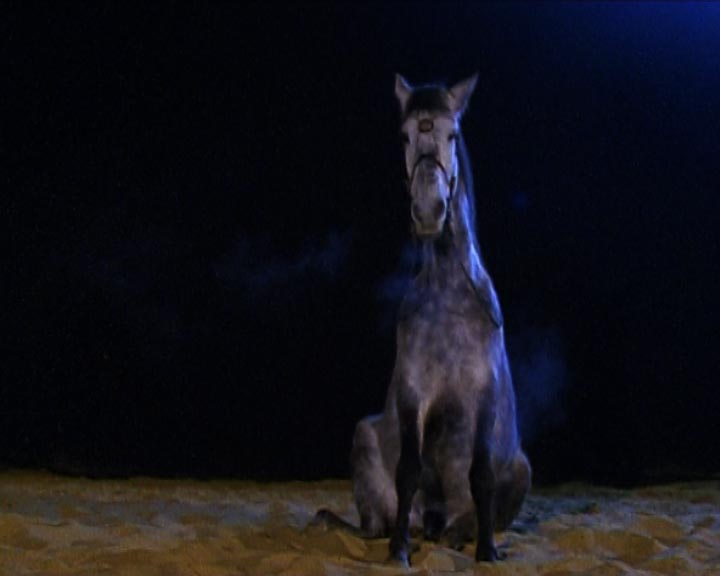
© » KADIST
Carolina Saquel Martinez
The artist films a horse dressage session at night, in a dimly lit manège. In this video the artist recalls the importance of traditional equestrian portraits in Spanish painting and relates to the repetitive passage between the rider and the mount. This effect of repetition is accentuated by the video played in a loop and the fixed framing of the image shot from the ground, with body posture and dressage themes as a method for training and obedience.

© » KADIST
Adriana Martínez
Her 2015 work Orión is a black flag-like cloth with glow-in-the-dark symbols embroidered in the shape of the constellation. In the place of stars, Martínez has substituted the logos of international corporations and entities that use stars as their symbol; celestial navigation commanded by the logic of international corporations. Easily spotted is the smiling face of the Carl’s Jr. / Hardee’s logo, the three-pronged Mercedes-Benz emblem, Walmart’s six-pointed asterisk, and the starry cluster of the Subaru shield.

© » KADIST
Carolina Caycedo
YUMA o la tierra de los amigos (YUMA, or the Land of Friends) by Carolina Caycedo is a large mural containing a series of satellite photographs mounted on acrylic. The mural contrasts and mixes multiple layers of these satellite images capturing the progressive devastation of the El Quimbo dam on the Yuma river (Magdalena), in the Department of Huila. The project was originally produced for the 8th Berlin Biennale, and developed out of the artist’s research into waterways, their political and cultural impact, and their historical development.

© » KADIST
Martine Syms
Her 2016 video installation quotes the sitcom-as-form and also draws from a 1907 comedic short, Laughing Gas. Syms’s 4-channel installation follows the central character (an aspiring artist also named Martine Syms) on a journey home from the dentist after receiving “laughing gas.” Mixing multiple points of view, clips borrowed from TV, as well as layers of comedy, fiction, reality, and critique, Syms’ work also delves into issues of race, culture, and representation. For Los Angeles-based Martine Syms, popular culture, television, and the cultural histories woven through both are starting points for her interdisciplinary art practice.

© » KADIST
Carolina Fusilier
Miercoles cerca de las 7 de la tarde by Caroline Fusilier portrays two quantum computers that are mobile, with human-esque legs, these are systems at the edge of biology. The floor is awash with fluid; perhaps a chemical resource consumed by the advanced computers or a heat-sink. Where their legs meet the fluid there’s a soft glow, less intense but related to the vibrant radiation on the wall above the figures.

© » KADIST
Carolina Caycedo
Carolina Caycedo’s practice conveys her very personal passion and relationship to water, as a powerful necessity and spiritual reminder. Esto No Es Agua / This Is Not Water is a portrait of the Las Damas waterfall in the town of Garzón, Huila in Southern Colombia. The video is composed of footage of the waterfall that is at times mirrored, distorted, obstructed, or kaldeiscoped in different ways.

© » KADIST
Carolina Caycedo
In this two-channel video installation, Spaniards Named Her Magdalena, But Natives Called Her Yuma , Carolina Caycedo gathered footage during numerous research trips to dam sites in the Harz Mountains, Saxony, Westphalia and the Black Forest in Germany interspersed with images of the Rio Magdalena region in Colombia. Extending beyond the documentary form, the work illuminates social power structures and control mechanisms, particularly in connection with the activities of multinational corporations: images of controlled bodies of water are spliced with footage of urban crowds, visualising overlaps in the ways these various bodies are managed. The film is overlaid with the narrator’s voice whispering in Spanish and English, speaking of the artist’s personal perspective, and her own experience with a river she has known since childhood when family lived by its edge.

© » KADIST
Claudia Martínez Garay
escenario chacana by Claudia Martínez Garay is a sculptural work composed of a frame-like structure that contains a series of ceramic pieces. It references the Chakana, an Andean cross that encompasses the different levels of existence (known as Pachas) and sacred elements contained in the Indigenous cosmologies of the region. It often appears in the geometrical motifs of textiles and ceramics.

© » KADIST
Caroline Déodat
Landslides is a cinematographic essay/poem by Caroline Déodat in which fictional images are the result of research into the memories of a Mauritian dance born during colonial slavery, the Sega. In the film, the contemporary Mauritian dancer Jean-Renat Anamah crosses mythical landscapes of the Sega that merge with intimate territories. From the pixels of the digital image and the signals of electronic music, this film exhumes in layers of landscapes the spectres of a ritual erased by history through a personal genealogy: between haunting memory and deferred archive.

© » KADIST
Manuel Solano
Since Manuel Solano became blind, they developed a technique that relies on audio descriptions that allow for an assistant to place pins and threads on a grid that guides the artist’s hands through the surface. In Los Abuelos , the artist works with a canvas the size of their body, allowing intense interaction with the wet paint. This kind of tactility creates a complex entanglement of color masses alternating sharp and blurred details, giving the image an erratic and affective atmosphere just as our fond memories often appear to us.
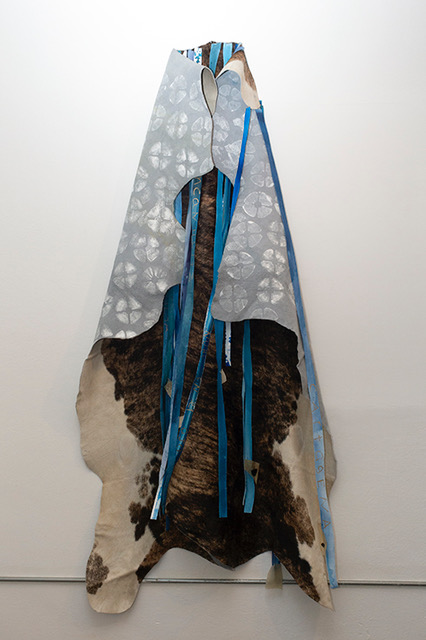
© » KADIST
Noé Martínez
As he investigates the forms that slavery took through different events that occurred during the sixteenth century in the Huasteca region of Mexico, Noé Martínez tells, in a non-linear narrative, the history of human trafficking in Relación de tráfico de personas 1525-1533 I (Study of Trafficking of Persons 1525–1533 I) . Both the departure of Huasteco Indians from the Americas, and the arrival of Africans from Cape Verde, Angola, Congo and Mozambique unravel in Martinez work as a story that has remained sealed in the colonial archives, and that continues under different guises in contemporary times. Relación de tráfico de personas 1525-1533 I is part of a series made of interventions in tanned leathers that refer to the exchange of human beings for pack animals and cattle in the Caribbean Sea.

© » KADIST
Adriana Martínez
Her work Al final del arcoiris (At the end of the rainbow, 2015) is a bundle of bills from Chile, Venezuela, Brazil, Colombia, Nicaragua, and Costa Rica, arranged by color to form a tight spiraling rainbow held close with a rubber band. Here, Martinez uses these various currencies to gesture towards questions of capital and value, the accumulation of wealth, and regional economies. Beneath the surface of her playful visual propositions, Martinez asks us to consider not only the monetary costs of international goods, but also the real, human consequences of a global economic culture that privileges some and devastates others.

© » KADIST
Martin Creed
This photograph of Martin Creed himself was used as the invitation card for a fundraising auction of works on paper at Christie’s South Kensington in support of Camden Arts Centre’s first year in a refurbished building in 2005. His broad smile, on the verge of laughter, encourages reciprocity on behalf of the onlooker. This could be said to be a typical tactic in Creed’s work as it is so infused with humor and irony.
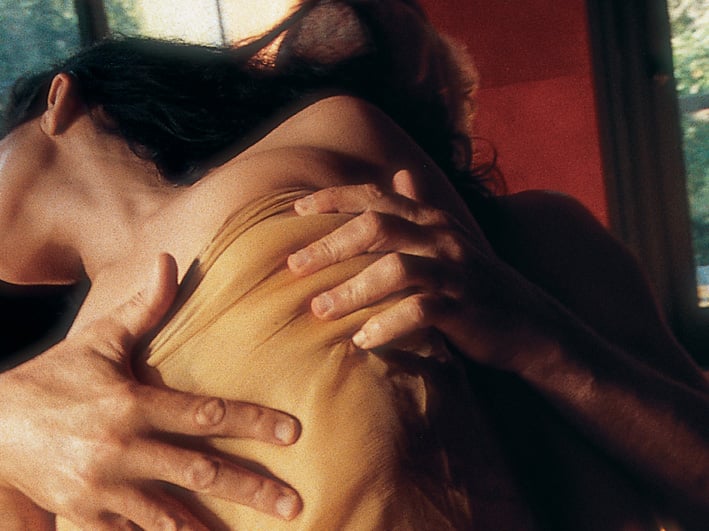
© » KADIST
Daria Martin
In keeping with her mythological proclivity, Minotaur (2009) casts a new light on an old narrative. The film takes the ancient Greek story of the half-man, half-bull as its title subject, but at its core, Minotaur is an homage to pioneering modern dancer and choreographer, Anna Halprin. Along with Trisha Brown, Simone Forti, and Yvonne Rainer, Halprin’s fearless and lifelong dance practice paved the way for the evolution of modern and contemporary dance as we understand it today.

© » KADIST
Carolyn Drake
Megan and Hazel Sue at Creekmore House by Carolyn Drake is from a series of works titled Knit Club . For this project, Drake collaborated with an enigmatic group of women in Mississippi who loosely call themselves “Knit Club”. The subject matter of this photograph centers on the relationship between the girl and doll in the painting, and the woman and girl in the photograph.

© » KADIST
Carolyn Lazard
Between 1951 and 1974, Dr. Albert M. Kligman, a professor of dermatology at the University of Pennsylvania, oversaw medical experiments conducted on incarcerated people at Holmesburg Prison in Philadelphia. These nontherapeutic tests ranged from athlete’s foot powders, dandruff shampoos, deodorants, and detergents, as well as more hazardous materials such as dioxin, radioactive isotopes, and mind-altering psychotropics. During his tenure at Holmesburg, Dr. Kligman worked for companies such as Johnson & Johnson, developing the acne medicine Retin-A, and for Dow Chemical Company and the U. S. Department of Defence, testing the ‘tactical herbicide’ Agent Orange.

© » KADIST
Carolyn Drake
Jackie and Chloe by Carolyn Drake is from a series of works titled Knit Club . For this project, Drake collaborated with an enigmatic group of women in Mississippi who loosely call themselves “Knit Club”. There is a strangeness to this photograph; details of facial identity are withheld.
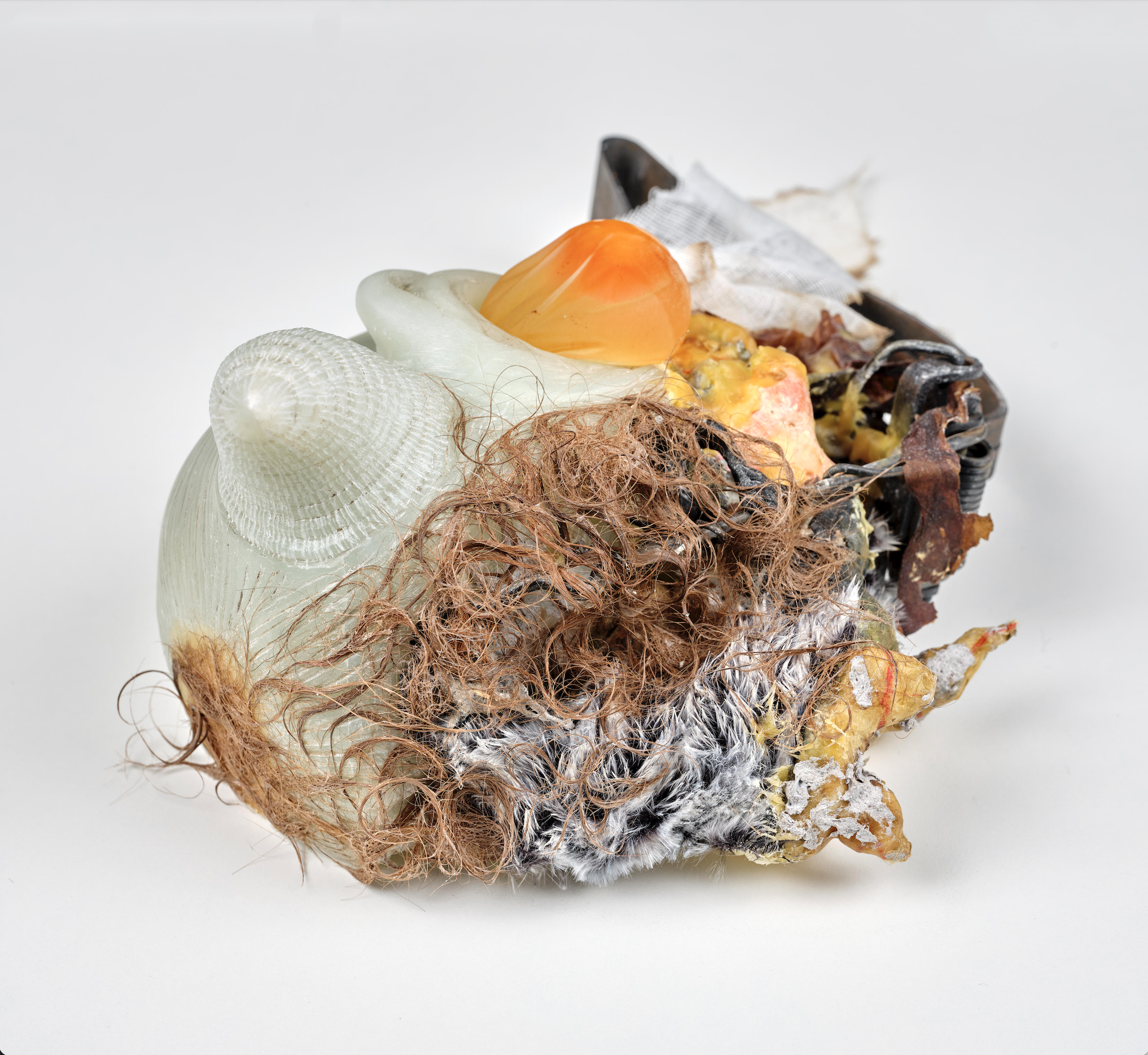
© » KADIST
Catalina Ouyang
font VII by Catalina Ouyang is part of an ongoing series of ‘fonts’, or sculptures, inspired by Catholic holy water vessels. This particular iteration from the series combines hand-carved soapstone, a stop loss trap, horse hair, fermented egg, and other elements to create an artwork that defies categorization. The work’s most notable feature is a small cavity that cradles a naked egg—a translucent, flaccid egg without its outer shell.

© » KADIST
Manuel Correa
Manuel Correa’s short film Didn’t Know I Died is a testimonial portrait of the acclaimed Colombian poet Olga Elena Mattei. Earlier in her life during a simple medical operation, Mattei was declared medically dead. In the film, she recounts her first memory upon waking up, a dream.

© » KADIST
Manuel Correa
Manuel Correa’s documentary Four Hundred Unquiet Graves is a powerful and vulnerable visual essay about the descendants of those who were disappeared during the Spanish Civil War from 1936–1939. The film reveals the spectrum of violence that surrounds the war, namely the impact of thousands of forced disappearances on different generations. Surviving family members are haunted not only by the absence of their grandparents, but also by the overwhelming grief that lives in their parents.

© » KADIST
Manuel Correa
La Forma del Presente (The Shape of Now) by Manuel Correa follows a group of survivors of Colombia’s 50-year long armed conflict facing the impossible task of agreeing on a shared past. After half a century of carnage, Colombia achieved peace. Despite an agreement between the government and the Revolutionary armed forces of Colombia (FARC_EP) being rejected by popular vote, the government chose to implement the agreements regardless, further polarizing the public opinion.

© » KADIST
Daniel Joseph Martinez
Martinez’s sculpture A meditation on the possibility… of romantic love or where you goin’ with that gun in your hand , Bobby Seale and Huey Newton discuss the relationship between expressionism and social reality in Hitler’s painting depicts the legendary Black Panther leaders Huey P. Newton and Bobby Seale. By using Carrara marble, a material usually associated with heroic public sculptures, Martinez casts the history of African-American revolutionaries into the artistic tradition of monumentality. Like the artist’s earlier work included in the 1993 Whitney Biennial, an interactive piece made up with pins that read, “I CAN’T IMAGINE EVER WANTING TO BE WHITE,” A meditation on the possibility… continues Martinez’s effort to expose cultural contradictions and increase public awareness.

© » KADIST
Daniel Joseph Martinez
Drawing & Print (Drawing & Print)
If Only God Had Invented Coca Cola Sooner! Or, The Death of My Pet Monkey

© » KADIST
Daniel Joseph Martinez
For I use to eat lemon meringue pie till I overloaded on my pancreas with sugar and passed out; It seemed to be a natural response to a society of abundance (1978), also known as the Bodybuilder series, Martinez asked male bodybuilding competitors to pose in whatever position felt “most natural.” They are obviously trained in presenting their ambitiously carved physiques, but their facial expressions seem comparatively unstudied. Against a bare white background, the men appear unexpectedly vulnerable, caught between performance and rehearsal, public and private. While they present themselves deliberately as exemplars of strength, they also inadvertently expose something about the value system that underlies their endeavors—whatever drove them to keep building by tearing tissue, and whatever makes flexing feel like the most honest pose possible.

© » KADIST
Martin Kippenberger
Drawing & Print (Drawing & Print)
7″ Single ‘Pop In’ by Martin Kippenbergher consisting of a vinyl record and a unique artwork drawn by the artist on the record’s sleeve. In the foreground of the album’s cover, a drawing of an empty, round vessel is framed underneath the text “POP IN”, suggesting an invitation to listen to the record, a nod to pop music, or perhaps a literal proposal to enter the vessel or the work. In the background, partly hidden by the round form, Kippenberger’s hand-drawn self portrait glares back at the viewer.

© » KADIST
Martin Boyce
In the installation Our Love is like the Flowers, the Rain, the Sea and the Hours, Martin Boyce uses common elements from public gardens – trees, benches, trashbins– in a game which describes at once a social space and an abstract dream space. The trees, unique sources of light in the exhibition space, produce their own environment. These sculptures, as if extracted from a set, are enough to suggest an atmosphere, a landscape, or a movie.

© » KADIST
Daria Martin
Soft Materials is a curious, touching but also disturbing sequence of confrontations between two people: a man and a woman, and machines. Shot in the Artificial Intelligence Laboratory at the University of Zurich, the humans and the machines mirror each other’s actions. It is unclear which party takes the lead.
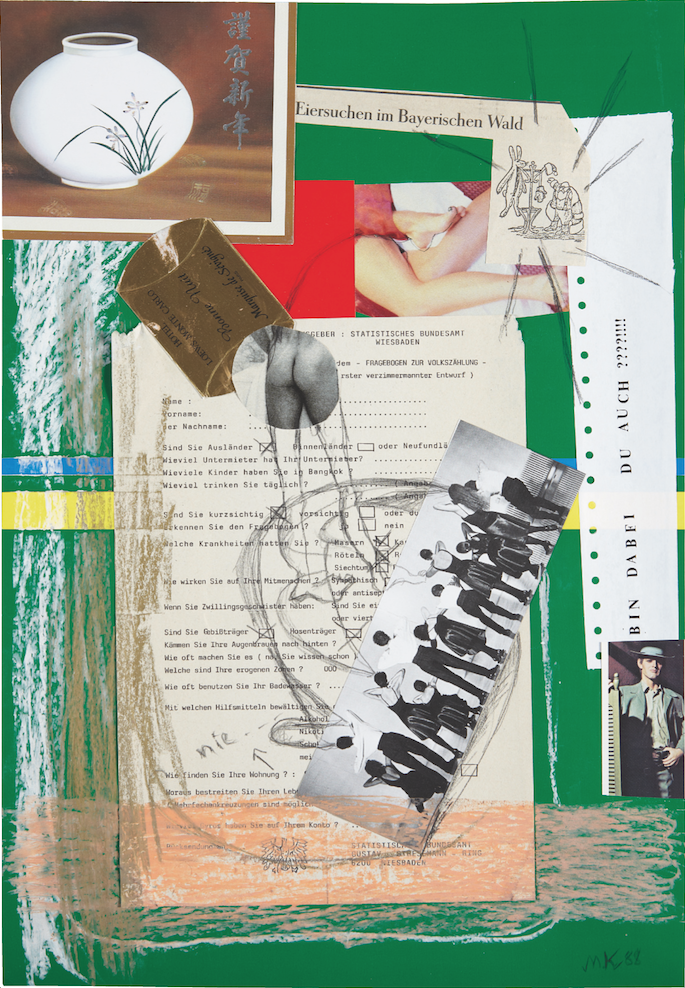
© » KADIST
Martin Kippenberger
Martin Kippenberger’s late collages are known for incorporating a wide range of materials, from polaroids and magazine clips to hotel stationery, decals, and graphite drawings. Untitled is a collage on paper work by Kippenberger that typifies his everything-goes approach: a barely discernible, sliced image of Michael Jackson’s face is overlaid and woven with strips and triangular shapes from a different source into a single composition. Blue tones come from torn out pages of a book where fragments of illustrations can be seen.

© » KADIST
Martin Kippenberger
Drawing & Print (Drawing & Print)
Untitled is a work on paper by Martin Kippenberger comprised of several seemingly disparate elements: cut-out images of a group of dancers, a japanese ceramic vase, and a pair of legs, are all combined with gestural, hand-drawn traces and additional elements such as a candy wrapper from a hotel in Monte Carlo and a statistical form from a federal government office in Wiesbaden, Germany. Text cut out from a Newspaper spells out in German “Egg hunting in the Bavarian forest” and an additional piece of text reads in all capitals “BIN DABEI DU AUCH” (“I’m here too” in English). Together, all the messages and geographies from the separate elements suggest an alternative, highly stylized portrait of the artist; in this case, a fragmented, fluid, and itinerant sense of identity.
Daniel Joseph Martinez
- location: Los Angeles, California
- year born: 1957
- gender: male
- nationality: American
- home town: Los Angeles, California
Martin Creed
- location: Wakefield, United Kingdom
- year born: 1968
- gender: male
- nationality: British
Martin Kippenberger
- location: Vienna, Austria
- year born: 1953
- gender: male
- nationality: German
- home town: Dortmund, Germany
Carolina Caycedo
Carolina Caycedo’s work triumphs environmental justice through demonstrations of resistance and solidarity...
Manuel Correa
Manuel Correa’s practice deals with the reconstruction of post-conflict intergenerational memory in contemporary societies...
Carolyn Drake
Carolyn Drake works on long term photo-based projects that involve travel and collaboration...
Daria Martin
A number of Daria Martin’s films explore the relationship between humans and machines and make reference to modernist art, whether through the work of the Bauhuas (Schlemmer), Surrealism (Giacometti’s Palace at 4 AM) or American art of the 1960s and 1970s...
Carolina Fusilier
Caroline Fusilier’s paintings are dark, foreboding, and ominous...
Carolyn Lazard
Carolyn Lazard’s practice centers disability and accessibility through sculpture, video, installation, and performance...
Martin Boyce
- location: Hamilton, United Kingdom
- year born: 1967
- gender: male
- nationality: British
Carolina Saquel Martinez
Caroline Saquel was born in Chile and now lives and works in Paris...
Manuel Solano
Manuel Solano, who is non-binary and prefers plural pronouns, was an emerging 26-year-old artist when they lost their sight to an HIV-related infection in 2013...
Catalina Ouyang
Catalina Ouyang investigates themes of desire, subjugation, and dissidence through object-making, transdisciplinary contexts, and time-based works...
Olive Martin and Patrick Bernier
Patrick Bernier and Olive Martin are a duo of artists collaborating since 1999...
Michael Craig-Martin
Michael Craig-Martin studied fine art at Yale University returning to Europe in the mid-1960s and becoming one of the key figures in the first generation of British conceptual artists...
Martine Syms
- location: Los Angeles, California
- year born: 1988
- gender: female
- nationality: American
- home town: Los Angeles, California
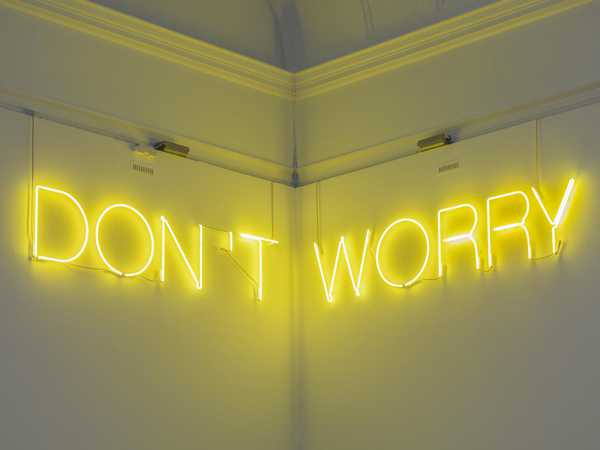
© » TATE EXHIBITIONS
about 4 months ago (01/06/2024)
Martin Creed | The Dick Institute Experience the work of one of this country’s most ingenious, audacious and surprising artists at the Dick Institute ARTIST ROOMS Martin Creed presents highlights from the British artist’s thirty-year career...
-
1970-1979
Daniel Joseph Martinez
1978For I use to eat lemon meringue pie till I overloaded on my pancreas with sugar and passed out; It seemed to be a natural response to a society of abundance (1978), also known as the Bodybuilder series, Martinez asked male bodybuilding competitors to pose in whatever position felt “most natural.” They are obviously trained in presenting their ambitiously carved physiques, but their facial expressions seem comparatively unstudied...
-
1980-1989
Martin Kippenberger
1988Martin Kippenberger’s late collages are known for incorporating a wide range of materials, from polaroids and magazine clips to hotel stationery, decals, and graphite drawings...
Martin Kippenberger
Drawing & Print
1989(Drawing & Print) 7″ Single ‘Pop In’ by Martin Kippenbergher consisting of a vinyl record and a unique artwork drawn by the artist on the record’s sleeve...
Martin Kippenberger
Drawing & Print
1989(Drawing & Print) Untitled is a work on paper by Martin Kippenberger comprised of several seemingly disparate elements: cut-out images of a group of dancers, a japanese ceramic vase, and a pair of legs, are all combined with gestural, hand-drawn traces and additional elements such as a candy wrapper from a hotel in Monte Carlo and a statistical form from a federal government office in Wiesbaden, Germany...
-
2000-2009
Martin Creed
2003This photograph of Martin Creed himself was used as the invitation card for a fundraising auction of works on paper at Christie’s South Kensington in support of Camden Arts Centre’s first year in a refurbished building in 2005...
Martin Boyce
2003In the installation Our Love is like the Flowers, the Rain, the Sea and the Hours, Martin Boyce uses common elements from public gardens – trees, benches, trashbins– in a game which describes at once a social space and an abstract dream space...
Daria Martin
2004Soft Materials is a curious, touching but also disturbing sequence of confrontations between two people: a man and a woman, and machines...
Daniel Joseph Martinez
2005Martinez’s sculpture A meditation on the possibility… of romantic love or where you goin’ with that gun in your hand , Bobby Seale and Huey Newton discuss the relationship between expressionism and social reality in Hitler’s painting depicts the legendary Black Panther leaders Huey P...
Daria Martin
2008In keeping with her mythological proclivity, Minotaur (2009) casts a new light on an old narrative...
-
2010-2019
Olive Martin and Patrick Bernier
2010The Mohawk, the emblematic Frontier river in the period of American colonisation, is here a cable of data transmission, and the 7 Sultans Casino is a virtual destination, one of the three hundred online casinos hosted by the servers located in Kahnawake, a small native american indian reserve to the south of Montreal...
Carolina Caycedo
2013In this two-channel video installation, Spaniards Named Her Magdalena, But Natives Called Her Yuma , Carolina Caycedo gathered footage during numerous research trips to dam sites in the Harz Mountains, Saxony, Westphalia and the Black Forest in Germany interspersed with images of the Rio Magdalena region in Colombia...
Carolina Caycedo
2014YUMA o la tierra de los amigos (YUMA, or the Land of Friends) by Carolina Caycedo is a large mural containing a series of satellite photographs mounted on acrylic...
Adriana Martínez
2015Her 2015 work Orión is a black flag-like cloth with glow-in-the-dark symbols embroidered in the shape of the constellation...
Carolina Caycedo
2015Carolina Caycedo’s practice conveys her very personal passion and relationship to water, as a powerful necessity and spiritual reminder...
Adriana Martínez
2015Her work Al final del arcoiris (At the end of the rainbow, 2015) is a bundle of bills from Chile, Venezuela, Brazil, Colombia, Nicaragua, and Costa Rica, arranged by color to form a tight spiraling rainbow held close with a rubber band...
Martine Syms
2016Her 2016 video installation quotes the sitcom-as-form and also draws from a 1907 comedic short, Laughing Gas...
Carolyn Drake
2018Megan and Hazel Sue at Creekmore House by Carolyn Drake is from a series of works titled Knit Club ...
Manuel Correa
2018La Forma del Presente (The Shape of Now) by Manuel Correa follows a group of survivors of Colombia’s 50-year long armed conflict facing the impossible task of agreeing on a shared past...
Claudia Martínez Garay
2019escenario chacana by Claudia Martínez Garay is a sculptural work composed of a frame-like structure that contains a series of ceramic pieces...
Noé Martínez
2019As he investigates the forms that slavery took through different events that occurred during the sixteenth century in the Huasteca region of Mexico, Noé Martínez tells, in a non-linear narrative, the history of human trafficking in Relación de tráfico de personas 1525-1533 I (Study of Trafficking of Persons 1525–1533 I) ...
-
2020-2029
Caroline Déodat
2020Landslides is a cinematographic essay/poem by Caroline Déodat in which fictional images are the result of research into the memories of a Mauritian dance born during colonial slavery, the Sega...
Manuel Solano
2020Since Manuel Solano became blind, they developed a technique that relies on audio descriptions that allow for an assistant to place pins and threads on a grid that guides the artist’s hands through the surface...
Manuel Correa
2020Manuel Correa’s short film Didn’t Know I Died is a testimonial portrait of the acclaimed Colombian poet Olga Elena Mattei...
Manuel Correa
2020Manuel Correa’s documentary Four Hundred Unquiet Graves is a powerful and vulnerable visual essay about the descendants of those who were disappeared during the Spanish Civil War from 1936–1939...
Catalina Ouyang
2021font VII by Catalina Ouyang is part of an ongoing series of ‘fonts’, or sculptures, inspired by Catholic holy water vessels...
Carolina Fusilier
2023Miercoles cerca de las 7 de la tarde by Caroline Fusilier portrays two quantum computers that are mobile, with human-esque legs, these are systems at the edge of biology...

